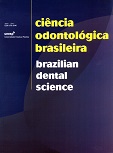Ação dos dentifrícios sobre a estrutura dental após imersão em bebida ácida – Estudo in vitro
DOI:
https://doi.org/10.14295/bds.2006.v9i2.498Abstract
RESUMO
O consumo de bebidas ácidas seguido de escovação pode causar grandes perdas de estrutura dental. Este estudo teve como objetivo avaliar o poder abrasivo de diferentes dentifrícios à dentina quando esta é submetida à imersão em suco de laranja. 70 segmentos de raízes bovinas foram divididos aleatoriamente em 10 grupos (n=7) em relação aos dentifrícios utilizados. G1: Sensodyne; G2: Controle (água destilada); G3: Sorriso Dentes Brancos; G4: Colgate Ação Total; G5: Close up Micropartículas; G6: Close up Liqui Fresh; G7: Phillips; G8: Colgate Controle do Tártaro; G9: Confident; G10: Tandy. Todos os grupos foram submetidos a 7.000 ciclos de escovação, sendo que a cada 1.000 ciclos foram imersos em suco de laranja por 90 s. Os dados iniciais e finais de peso e perfil foram obtidos em balança analítica e projetor de perfil respectivamente. Os resultados foram submetidos ao teste de Kruskal-Wallis. A maior perda de peso ocorreu no grupo G10 e a menor no G4, porém não se encontrou diferença estatisticamente significante entre os grupos. As maiores perdas de perfil ocorreram nos grupos G3, G6, G7, G10 sendo estatisticamente significante (p<0,05) em relação aos grupos G1, G2, G4, G5, G8, G9. A escovação com os dentifrícios Sorriso, Close up Liqui Fresh, Phillips e Tandy associada à bebida ácida produziram maior perda de estrutura dental.
Downloads
Downloads
Published
How to Cite
Issue
Section
License
Brazilian Dental Science uses the Creative Commons (CC-BY 4.0) license, thus preserving the integrity of articles in an open access environment. The journal allows the author to retain publishing rights without restrictions.
=================




























